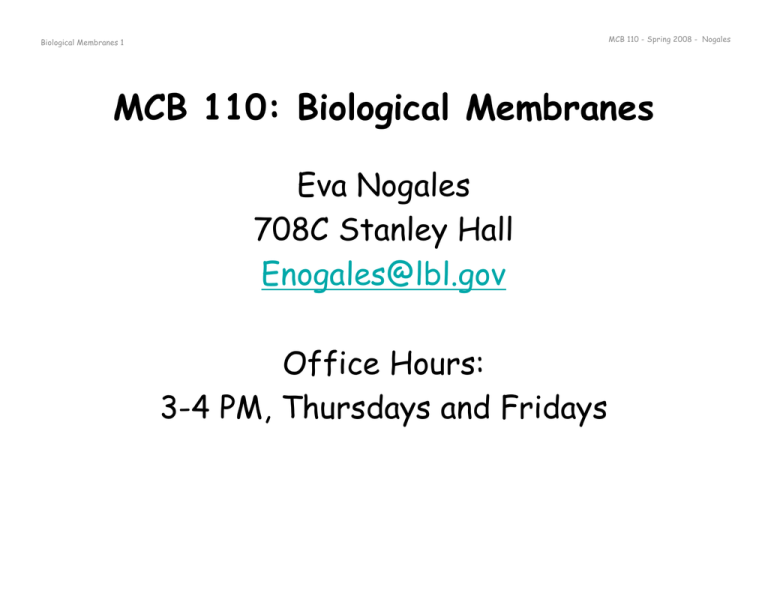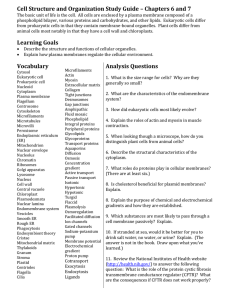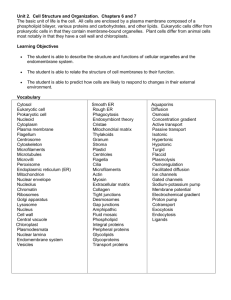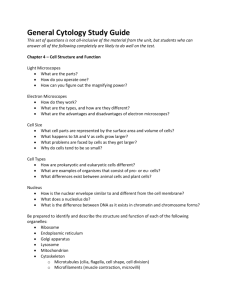MCB 110: Biological Membranes Eva Nogales 708C Stanley Hall Office Hours:
advertisement

MCB 110 - Spring 2008 - Nogales Biological Membranes 1 MCB 110: Biological Membranes Eva Nogales 708C Stanley Hall Enogales@lbl.gov Office Hours: 3-4 PM, Thursdays and Fridays MCB 110 - Spring 2008 - Nogales Biological Membranes 2 MCB 110 BIOLOGICAL MEMBRANES 1 MEMBRANE LIPIDS AND LIPID BILAYER I Intro to Biological Membranes II Membrane Lipids III Lipid Self-Assembly IV Membrane Fluidity 2 MEMBRANE PROTEINS I Introduction to Membrane Proteins II Integral Membrane Proteins III Peripheral Membrane Proteins IV Lipid-Anchored Membrane Proteins V Diffusion of Membrane Proteins 3 TRANSPORT ACROSS MEMBRANES I Intro: Permeability of the Cell Membranes II Diffusion III Facilitated Diffusion IV Active Transport V Membrane Potential and Nerve Impulses 4 MEMBRANE TRAFFICKING I Introduction: Secretory Pathway II Endoplasmic Reticulum III Golgi IV Vesicle Transport V Lisosomes VI Endocytosis 5 CELL SIGNALING I Introduction II G Protein-coupled Receptors III Receptor Tyrosine Kinases IV Integrin Signaling V Cell Signaling and Apoptosis VI Relationships between Biological Membranes 3 Suggested Reading: Lodish, Chapter 5 - 5.1 (Chapter 10.1 in new edition!); Alberts, Chapter 10 MCB 110 - Spring 2008 - Nogales Biological Membranes 4 MCB 110 - Spring 2008 - Nogales Biological Membranes 5 MCB 110 - Spring 2008 - Nogales Biological Membranes 6 MCB 110 - Spring 2008 - Nogales Biological Membranes 7 MCB 110 - Spring 2008 - Nogales Biological Membranes 8 MCB 110 - Spring 2008 - Nogales MCB 110 - Spring 2008 - Nogales Biological Membranes 9 B A Error in original table!! Biological Membranes 10 MCB 110 - Spring 2008 - Nogales Biological Membranes 11 MCB 110 - Spring 2008 - Nogales MCB 110 - Spring 2008 - Nogales Biological Membranes 12 IV Membrane Fluidity IV A – Definition and Function • Fluidity is defined as “easy of flow” and is opposed to viscosity (resistance to flow). Lipids bilayer are fluid in the liquid crystal state, but under the melting temperature Tm become rigidified: liquid crystal to gel transition. Fluidity of a biological membrane is required for movement of membrane proteins, and for processes requiring membrane fusion such as cell division or exocytosis IV B – Effect of Lipid Composition •Very sensitive to the presence of unsaturated fatty chains (one or more double bonds) that make packing difficult and thus decrease the Tm. In contrast saturated lipids have very high melting temperatures. •The length of the fatty acid chain also influences Tm. The longer the chain the larger the energy of packing. Thus, shorter chains result in lower melting temperatures. Bacteria control the fluidity of their membrane in changing environments by regulating the synthesis of lipids (with shorter of longer chains) and by desaturation. •Exp. – Doubling time larger at the restricted temperature for bacteria with mutant desaturases. Biological Membranes 13 MCB 110 - Spring 2008 - Nogales MCB 110 - Spring 2008 - Nogales Biological Membranes 14 • Cholesterol h as an important effect in membrane fluidity. Its ring structure rigidifies the membrane, but it also makes transition to gel phase more difficult by hindering packing of phospholipids. The net effect is a broadening of the transition. • Eukaryotes control fluidity by changes the amount of cholesterol present in the membrane. MCB 110 - Spring 2008 - Nogales Biological Membranes 15 IV D – Lipid Distribution in the leaflets • The lipid composition of the bilayer in the two leaflets is unequal at the cell membrane, giving the two sides very specific properties. MCB 110 - Spring 2008 - Nogales Biological Membranes 16 Membrane Thickness Membrane Curvature MCB 110 - Spring 2008 - Nogales Biological Membranes 17 Cholesterol and sphingolipids form rigid microdomains or rafts (~ 70 nm in diameter). These rafts concentrate certain membrane proteins and are important in cell signaling. Biological Membranes 18 IV C - Lipid Mobility: lateral movement and flip-flop Lipids are free to move laterally in a lipid bilayer Flip-flop movement is very energetically unfavorable and in the cell is catalyzed by flippases. MCB 110 - Spring 2008 - Nogales MCB 110 - Spring 2008 - Nogales Biological Membranes 19 MEMBRANE PROTEINS I Introduction • Models of biological membranes • Protein/lipids ratios • Asymmetric orientation in membranes • Types of membrane proteins II Integral Membrane Proteins • Amphipatic character • Visualization by freeze-fracture • Purification • Structural characterization III Peripheral Membrane Proteins A. Non-covalent association. Extraction methods B. Functions IV Lipid-anchored Proteins A. Outside leaflet. GPI B. Inside leaflet V Diffusion of Membrane Proteins A. Cell fusion experiments B. FRAP C. S P T Suggested Reading: Lodish, Chapter 5 - 5.2 (Chapter 10.2 in new edition!) Alberts, Chapter 10 MCB 110 - Spring 2008 - Nogales Biological Membranes 20 I INTRODUCTION II A – MODELS MEMBRANES OF B IOLOGICAL Initial models of biological membranes included only lipids. In the 20’s and 30’s hints from solubility and surface tension experiments indicated that there were other components in addition to lipids. An initial model of a b iological membrane that included proteins had the proteins lining the lipid bilayer with proteins. In 1972 Singer and Nicholson proposed the fluid mosaic model of the membrane that proteins we used today. In this model membranes both link to lipids or across the bilayer move in a sea of fluid lipid. While this model is overall correct is has its limitations. For example, we now know that certain components of the cell membrane can be fixed in space by attachment to the underlying cytoskeleton. Biological Membranes 21 MCB 110 - Spring 2008 - Nogales IC – Types of Membrane Proteins Proteins associated with membranes can be classified into three different types depending on the type of interaction they have with the bilayer. 1 – Integral Membrane Proteins pass through the lipid bilayer 2 – Peripheral Proteins associate with the bilayer by non-covalent interactions 3 – Lipid-anchored Proteins Biological Membranes 22 MCB 110 - Spring 2008 - Nogales II Integral Membrane Proteins II A – Proteins that traverse the lipid bilayer have a surface with amphipathic character, in contrast with the hydrophilic nature of the surface of soluble proteins. Hydrophilic residues are present also on the inside of the protein, making hydrogen bonds with ligands or with one another, or forming aqueous channels. Biological Membranes 23 MCB 110 - Spring 2008 - Nogales II B – Integral membrane proteins can be directly visualized by freezefracture and electron microscopy. Biological Membranes 24 MCB 110 - Spring 2008 - Nogales Biological Membranes 25 MCB 110 - Spring 2008 - Nogales Biological Membranes 26 II C – Purification of membrane proteins involves solubilization by detergents that bind to the hydrophobic parts of the protein surface. Below the Critical Micelle Concentration (CMC) the detergent molecules can solubilize the protein without forming detergent micelles Ionic detergents like SDS (sodium dodecyl sulphate) result in the denaturation of the protein. Milder, non-ionic detergents like Triton X-100 are commonly used for solubilization while preserving the structure of the protein. MCB 110 - Spring 2008 - Nogales Biological Membranes 27 II D – Structural Characterization • Special problems of Integral Membrane Proteins Difficult overexpression – Formation of inclusion bodies in host cell Need to solubilized Possible loss of function in detergent • X-ray and Electron Crystallographies Because of the difficulty of producing and solubilizing integral membrane proteins, only the structures of a few have been obtained to date by X-ray crystallography. The first structure was that of the bacterial photosynthetic reaction center, which resulted in the Nobel price for J. Deisenhofer. This complex of 4 proteins carries out the primary photochemical process of photosynthesis in purple bacteria. The transmembrane section is formed by the H, M and L subunits (purple, blue and orange), with 11 transmembrane helices. The chromophores are shown in yellow. The green part is on the external side of the membrane. Recently a number of ion channel structures have also been obtained by this method. MCB 110 - Spring 2008 - Nogales Biological Membranes 28 An alternative is electron crystallography, where crystals are 2-dimensional and are studied in an electron microscope. The advantage is the possibility of studying naturally occurring 2-D crystalline patches of membrane proteins as they occur in the cell (e.g. bacteriorhodopsin, gap junctions) or to form 2D crystals in vitro by reconstitution of solubilized proteins into lipid bilayers. The first structure solved by this method was that of bacteriorhodopsin (bR) by R. Henderson. This proton pump is formed by 7 transmembrane helices and a covalently bound retinal chromophore. Light changes the structure of the retinal, which in term changes that of the protein resulting in the movement of one proton from the inside to the outside of the cell. MCB 110 - Spring 2008 - Nogales Biological Membranes 29 • Transmembrane Domains The most common motive for transmembrane segments in an integral membrane protein is an alpha helix or a bundle of helices. An alternative is the beta-barrel structure observed in bacterial porins. These proteins exist in the outer membrane of gram-negative bacteria and in mitochondria. They are involved in the passive transport of small molecules across the membrane. They exist as trimers, each of the monomers with a central hydrophilic channel. MCB 110 - Spring 2008 - Nogales MCB 110 - Spring 2008 - Nogales Biological Membranes 30 • Hydropathy Plots In many cases the structure of membrane proteins cannot be obtained, but their integral character and the number of helical transmembrane segments can be predicted by analysis the amino acid sequence using hydropathy plots. These plots give an estimation of the local hydrophobicity for each residue in the structure. Hydrophobic stretches of 20-30 amino acids are a good indication of a transmembrane region. The Thepitch pitchof ofan analpha alphahelix helixis is 5.4 Å 3.6 and involves involves residues.3.6 Thus, residues. Thus, theÅ. rise per per residue is 1.5 Given residue is 1.5section Å. Given hydrophobic ofthat a lip the hydrophobic section of is 3 0 Å wide, it t akes a a lipid bilayer is about 30 Å, residues to go 20 across it, mo it takes about residues helix is not it,perpendicular to go across more if the bilayer. helix is not perpendicular to the bilayer. Biological Membranes 31 III Peripheral Membrane Proteins 1 - Peripheral membrane proteins are located outside of the membrane bilayer, either on the citosolic or extracellular side, and are associated to the membrane surface by non-covalent bonds. 2 – They can be extracted by treatment of the membrane with high salt or alkaline pH. 3 – Inside the cell peripheral membrane protein function include: linking the membrane to th e underlying cellular cytoskeleton (permanent attachment to the membrane); serving as signal transduction elements (the protein comes on and off the membrane). 4 – Peripheral proteins associated to the external side of the plasma membrane are typically associated with the extracellular matrix (ECM). They are mostly fibrous proteins that confer mechanical properties to tissues. MCB 110 - Spring 2008 - Nogales Biological Membranes 32 IV Lipid-anchored proteins 1 – Proteins on the outside surface are covalently linked to the membrane by a short oligosaccharide linked to a molecule of glycophosphatidylinositol (GPI) that is embedded in the outer leaflet. They are released by a phospholipase specific for inositol-containing phospholipids. One of such proteins is responsible for sleeping sickness. The tsetse flies carry an extracellular protozoan parasite that survives in the blood by virtue of a dense cell surface coat made of a GPI anchored glycoprotein. The parasites have several hundred variants of these glycoproteins so that they evade the host immune system by antigenic variation. 2 – In the inside of the plasma membrane some proteins are linked to the membrane by a long hydrocarbon chain embedded in the inner leaflet. Examples include oncogenes such as Src and Ras involved in cell proliferation signaling. MCB 110 - Spring 2008 - Nogales Biological Membranes 33 MCB 110 - Spring 2008 - Nogales Biological Membranes 34 MCB 110 - Spring 2008 - Nogales Biological Membranes 35 MCB 110 - Spring 2008 - Nogales Biological Membranes 36 V B - FRAP MCB 110 - Spring 2008 - Nogales Biological Membranes 37 MCB 110 - Spring 2008 - Nogales Biological Membranes 38 MCB 110 - Spring 2008 - Nogales





